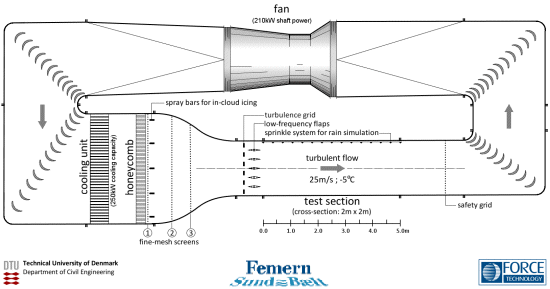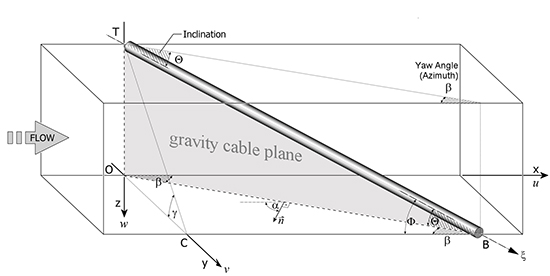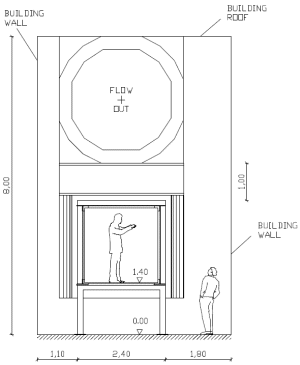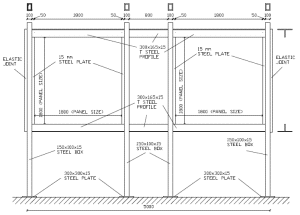Background
The newly proposed Femern fixed link between Denmark and Germany will push the limits in engineering design. The selection of a cable-stayed or suspension bridge will lead to one of the longest bridges of its type in the world. The challenges of designing a bridge are many and the prospects of cable vibrations already preoccupy both the owners and designers. In this connection, the Danish owners/operators Femern Bælt A/S, together with Storebælt A/S, are funding a collaborative research project to examine the ways of reducing the risk of cable vibrations on a bridge solution. A novel climatic wind tunnel facility, dedicated to the testing of structural cables, is being developed as part of this research project.

Principle sketch of the Closed-circuit Climatic Wind Tunnel including main features.

Coordinate system and geometric parameters defining the orientation of an inclined cable segment in the test section.
Special Feature
The capability of recreating the climatic conditions for ice accretion on the cable surface is a particular feature of the new CWT facility. The general condition for which ice accretion is simulated is best described as icing in supercooled clouds at low altitude. Supercooled clouds consist of liquid water droplets significantly below their nominal freezing point. To replicate such conditions the droplets in the water spray need to be homogeneously distributed in the flow approaching the cable section and the spray density, i.e. the liquid water content, LWC, should be constant over time. To meet the experimental conditions fulfilling the requirements for proper simulation of in-cloud icing large effort is presently made to develop and fine tune a suitable air cooling and water spray system.

Design Concept
Wind-tunnel testing of cables needs to be undertaken at appropriate Reynolds numbers and preferably at full scale, as certain forms of wind-induced vibration are highly dependent on this number and on the correct formation of rain or ice. Smaller low-speed wind-tunnels are often unable to achieve the necessary Reynolds numbers without significant levels of blockage. Apart from wind-tunnel blockage, the physics of ice accumulation including thermodynamic effects and rivulet establishment for rain conditions are significantly biased at reduced scale. As several of the most dominant wind-induced vibrations occur within the subcritical and critical Reynolds number regions, it is desirable that a wind-tunnel test facility should be able to test up to at least the supercritical range.

Sectional cut through wind tunnel at test section.
Additionally, a suitable wind-tunnel test facility will be able to test cables for varying wind angles-of-attack. An examination of the existing cable-stayed bridges reveals that bridge cables with angles of inclination of less than 22.5deg would start to become structurally inefficient. Consequently, a test section of 2m height would result in a section length of approximately 5m.

Side view on test section.
A closed-circuit type was chosen especially with respect to control air temperature at any time for simulating the relevant climatic conditions. All components of the wind tunnel have been optimized to reduce the induced pressure loss. The size of the wind tunnel is a compromise of aerodynamic design necessity and available space. To house the facility major reconstruction work was required as well as an expansion of the power supply relay station of FORCE Technology's testing facility.
Specification
The design specification listed below are based on the research requirements discussed above. In spring 2010 first results will be available with detailed information on the achieved flow and climatic test conditions.
| Property/dimension |
Value
|
| Test section inner cross-section |
2.0 x 2.0m
|
| Test section length |
5.0m
|
| Maximum airspeed in turbulent flow |
25m/s
|
| Maximum airspeed in smooth flow |
30m/s
|
| Range of turbulence intensity Iu |
1% to 20%
|
| Cloud air vapor density |
0.4g/m^3
|
| Droplet size |
10 to 50µm
|
| Minimum air temperature at max. speed |
-5degC
|